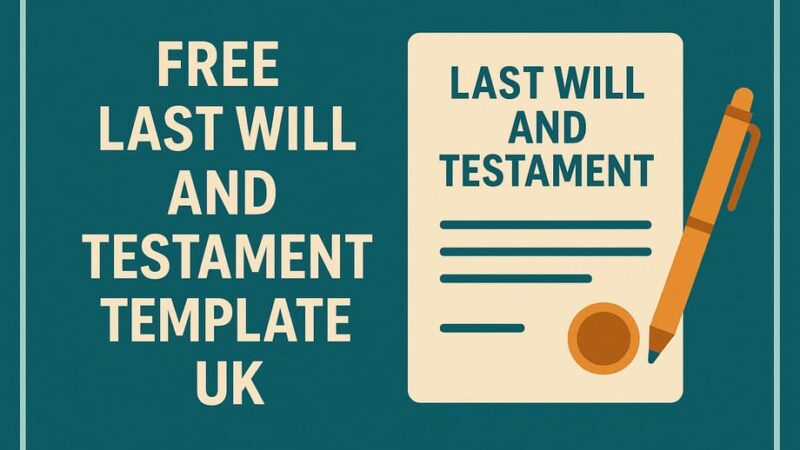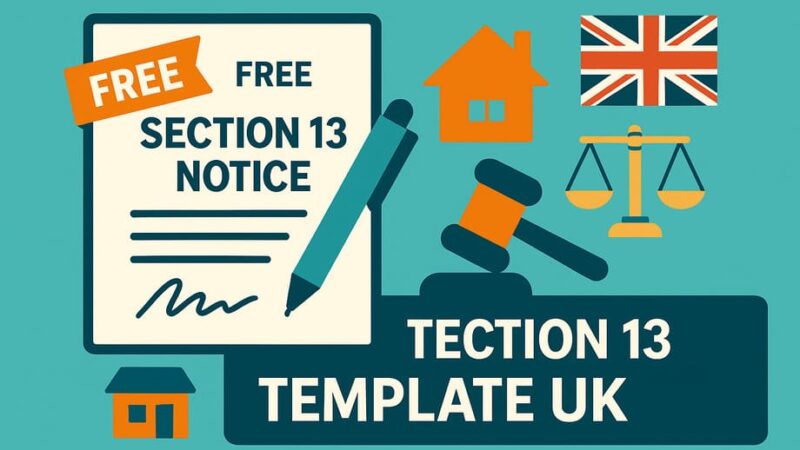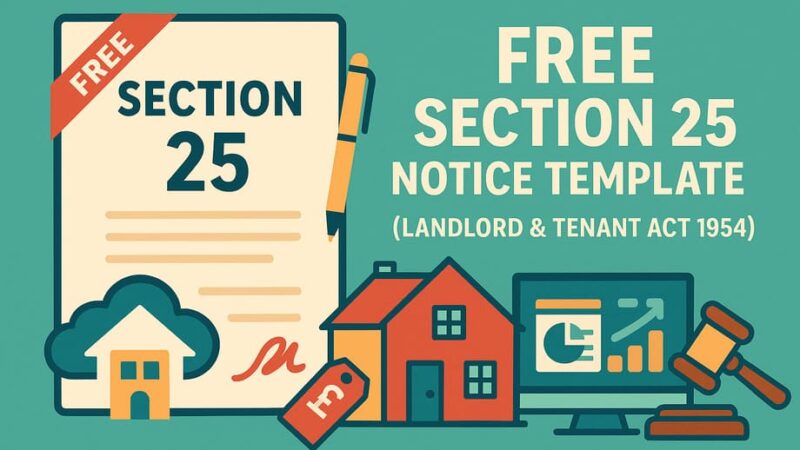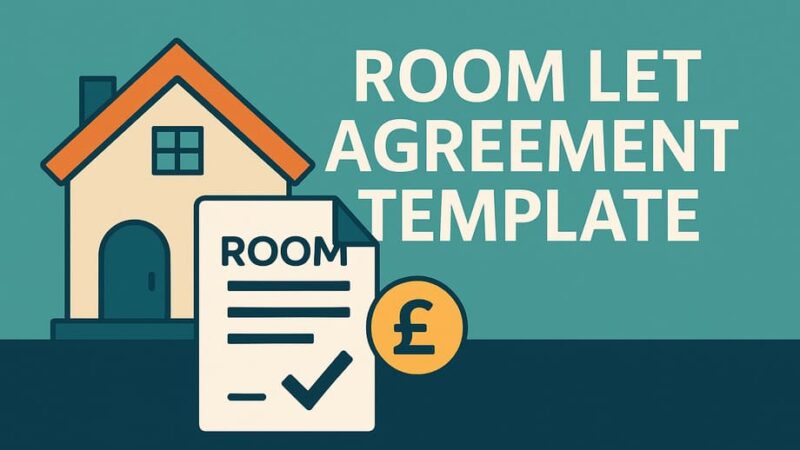Deposit Return Letter Template UK

When tenancies end, returning deposits promptly and fairly is essential for both landlords and tenants. Whether you’re a tenant requesting your deposit back or a landlord responding to deposit return requests, having the right letter template ensures clear communication and compliance with UK deposit protection scheme requirements.
This guide provides free deposit return letter templates for both landlords and tenants, covering everything from initial requests to dispute resolution. We’ll explain when tenants can request deposits back, landlord responsibilities under deposit protection schemes, and how to handle common disputes professionally.
When Tenants Can Request Deposit Back
Understanding when tenants have the right to request deposit returns helps both parties navigate the process correctly and avoid unnecessary disputes.
End of Tenancy Requirements
Completion of Tenancy Agreement Tenants can request deposit returns when their tenancy agreement ends, whether through natural expiry of fixed terms, proper notice during periodic tenancies, or mutual agreement to terminate early. The key requirement is that the tenancy must be legally concluded.
Simply moving out without proper notice or before fixed terms expire doesn’t automatically entitle tenants to deposit returns, as they may remain liable for rent and other obligations under the tenancy agreement.
Property Handover and Key Return Most tenancy agreements require tenants to return all keys and provide landlords with access for final inspections before deposit returns can be processed. This handover process allows landlords to assess property condition and determine any deductions needed.
Tenants should ensure they complete all checkout procedures specified in their tenancy agreements and obtain receipts or confirmation that keys have been returned and the property handed back satisfactorily.
Deposit Protection Scheme Compliance
Landlord Protection Obligations Under UK law, landlords must protect deposits in government-approved schemes (such as DPS, MyDeposits, or TDS) within 30 days of receipt. Tenants can request deposit returns at any time if landlords have failed to protect deposits properly, regardless of tenancy status.
Unprotected deposits give tenants strong grounds for immediate return plus compensation of 1-3 times the deposit amount, making proper protection essential for landlords.
Prescribed Information Requirements Landlords must provide tenants with prescribed information about deposit protection within 30 days of protection. If this information wasn’t provided correctly, tenants may have grounds for deposit return and compensation claims.
Mid-Tenancy Return Scenarios
Joint Tenancy Changes When joint tenants leave during ongoing tenancies, deposit returns become more complex as remaining tenants typically continue with liability for the full deposit amount. Departing tenants may need to negotiate directly with remaining tenants or seek landlord agreement for partial returns.
Early Termination by Agreement If landlords and tenants agree to early termination, deposit return procedures should be clearly agreed as part of the termination arrangement. Without clear agreements, disputes often arise about whether deposits should be returned or retained for early termination costs.
Landlord Breach Situations When landlords breach tenancy agreements seriously (such as failing to carry out essential repairs), tenants may have grounds to terminate tenancies early and demand immediate deposit returns plus compensation.
Landlord’s Responsibilities Under DPS/TDS
Understanding deposit protection scheme requirements ensures landlords comply with legal obligations and handle deposit returns correctly.
Initial Protection Requirements
30-Day Protection Deadline Landlords must protect tenant deposits in approved schemes within 30 days of receipt, regardless of tenancy type or deposit amount. This protection creates formal records and establishes procedures for dispute resolution if return disagreements arise.
The protection period begins when landlords receive deposits, not when tenancies begin, making prompt action essential to avoid compliance breaches.
Prescribed Information Provision Along with deposit protection, landlords must provide tenants with prescribed information including scheme details, landlord contact information, deposit amount and protection date, and procedures for deposit return and dispute resolution.
This information must be provided within 30 days of protection and should be kept by tenants throughout their tenancy as it contains essential details for deposit recovery.
End of Tenancy Obligations
10-Day Return Timeline When tenancies end and no disputes exist about deposit returns, landlords should return deposits within 10 working days. This timeline demonstrates good practice and helps maintain positive tenant relationships.
For deposits held in custodial schemes, both parties must agree to return arrangements before funds are released. For insurance-backed schemes, landlords control returns but must follow scheme procedures.
Dispute Notification Requirements If landlords intend to make deductions from deposits, they must notify tenants promptly with detailed explanations of proposed deductions, supporting evidence such as receipts and photos, and opportunities for tenants to respond before final decisions.
Most deposit protection schemes require formal notification of disputes within specific timeframes, making prompt communication essential for valid deduction claims.
Documentation and Evidence Standards
Comprehensive Record Keeping Successful deposit deductions require detailed documentation including check-in and check-out inventories, photographs showing property condition at both tenancy start and end, receipts for any cleaning or repair work, and evidence of tenant responsibility for claimed damage.
Without adequate documentation, deposit protection scheme adjudicators typically favor tenants in dispute cases, making thorough record-keeping essential for landlords.
Professional Inventory Services Many landlords use professional inventory clerks to create independent records of property condition that carry more weight in dispute proceedings than landlord-prepared inventories.
Professional inventories reduce disputes and provide credible evidence for legitimate deductions when problems do arise.
Free Deposit Return Letter Templates
Here are professional templates for both tenants requesting returns and landlords responding to requests:
Tenant Request Letter Template
[Your Name]
[Your Current Address]
[City, Postal Code]
[Phone Number]
[Email Address]
[Date]
[Landlord's Name]
[Landlord's Address]
[City, Postal Code]
Dear [Landlord's Name],
Re: DEPOSIT RETURN REQUEST - [Rental Property Address]
I am writing to formally request the return of my tenancy deposit following
the end of my tenancy at the above property.
TENANCY DETAILS:
• Tenant name(s): [Your name and any joint tenants]
• Property address: [Full rental property address]
• Tenancy start date: [Date]
• Tenancy end date: [Date]
• Deposit amount: £[Amount]
• Deposit protection scheme: [DPS/MyDeposits/TDS/Unknown]
TENANCY COMPLETION:
I confirm that I have:
• Vacated the property on [date]
• Returned all keys and access devices
• Left the property clean and in good condition
• Provided forwarding address for correspondence
• Completed all checkout procedures as required
DEPOSIT PROTECTION INFORMATION:
[Choose appropriate section:]
If deposit was protected:
The deposit was protected with [scheme name] under reference [reference
number if known]. I understand that you have 10 working days to return
the deposit if no deductions are claimed.
If deposit protection status unknown:
Please confirm which scheme my deposit was protected with and provide
the scheme reference number. If the deposit was not properly protected,
I request immediate return plus compensation as required by law.
FORWARDING ADDRESS FOR DEPOSIT RETURN:
[Your new address]
[City, Postal Code]
PAYMENT METHOD REQUEST:
Please return the deposit by:
☐ Bank transfer to: [Account details]
☐ Cheque posted to above address
☐ Other method: [Specify]
DEDUCTION DISPUTES:
If you intend to make any deductions from the deposit, please provide:
• Detailed explanation of each proposed deduction
• Supporting evidence (receipts, photographs, reports)
• Opportunity to discuss any disputed items
• Formal dispute notification through the deposit protection scheme
LEGAL REQUIREMENTS:
Under the Housing Act 2004 and deposit protection regulations, deposits
must be returned promptly when tenancies end. If you fail to return my
deposit or cannot justify proposed deductions, I may pursue recovery
through the deposit protection scheme's dispute resolution service.
CONTACT INFORMATION:
Please contact me on [phone number] or [email address] if you need to
discuss this request or arrange any final property matters.
I look forward to receiving confirmation of deposit return arrangements
within 7 days of this letter.
Yours sincerely,
[Your Signature]
[Your Printed Name]
[Date]
COPIES SENT TO:
☐ Deposit Protection Scheme
☐ Citizens Advice
☐ Other: [Specify if applicable]
Landlord Response Letter – Full Return
[Your Name]
[Your Address]
[City, Postal Code]
[Phone Number]
[Email Address]
[Date]
[Tenant's Name]
[Tenant's Address]
[City, Postal Code]
Dear [Tenant's Name],
Re: DEPOSIT RETURN - [Property Address]
Thank you for your letter dated [date] requesting return of your tenancy
deposit. I am pleased to confirm that your deposit will be returned in full.
DEPOSIT RETURN DETAILS:
• Property address: [Full address]
• Tenancy period: [Start date] to [End date]
• Deposit amount: £[Amount]
• Protection scheme: [Scheme name]
• Scheme reference: [Reference number]
PROPERTY CONDITION ASSESSMENT:
Following inspection of the property on [date], I am satisfied that:
• The property has been left in good condition
• All keys and access devices have been returned
• No damage beyond normal wear and tear has occurred
• Cleaning standards are acceptable
• No deductions are required
RETURN ARRANGEMENTS:
Your deposit of £[amount] will be returned as follows:
• Payment method: [Bank transfer/Cheque]
• Payment date: [Date - within 10 working days]
• [If bank transfer] Reference: [Deposit return - property address]
[For custodial schemes add:]
I have instructed [scheme name] to release your deposit in full. You should
receive payment directly from the scheme within [timeframe].
[For insurance schemes add:]
Payment will be made directly from my account as detailed above.
FINAL MATTERS:
• Utility meter readings taken: [Details if applicable]
• Council tax liability ends: [Date]
• Any forwarding mail will be returned to sender after [date]
Thank you for being a responsible tenant and maintaining the property well
during your tenancy. I would be happy to provide a positive landlord
reference if required for future rental applications.
If you have any questions about this deposit return, please contact me on
[phone number] or [email address].
Yours sincerely,
[Your Signature]
[Your Printed Name]
[Date]
Landlord Response Letter – Partial Return with Deductions
[Your Name]
[Your Address]
[City, Postal Code]
[Phone Number]
[Email Address]
[Date]
[Tenant's Name]
[Tenant's Address]
[City, Postal Code]
Dear [Tenant's Name],
Re: DEPOSIT RETURN WITH DEDUCTIONS - [Property Address]
Thank you for your deposit return request dated [date]. Following inspection
of the property, I need to make deductions for damage and costs beyond
normal wear and tear.
DEPOSIT BREAKDOWN:
• Original deposit: £[Amount]
• Total deductions: £[Amount]
• Amount to be returned: £[Amount]
DETAILED DEDUCTIONS:
1. Cleaning costs: £[Amount]
Reason: [Specific areas requiring professional cleaning]
Evidence: Receipt from [cleaning company] dated [date]
2. Damage repairs: £[Amount]
Reason: [Specific damage description and location]
Evidence: Repair receipt from [contractor] dated [date]
Before/after photos: [Reference to attached photos]
3. Missing items: £[Amount]
Reason: [Items missing from inventory]
Evidence: Check-in inventory showing items provided
4. [Additional deductions as applicable]
SUPPORTING EVIDENCE:
Attached to this letter:
☐ Check-in inventory dated [date]
☐ Check-out inventory dated [date]
☐ Photographs showing damage/cleaning issues
☐ Receipts for all claimed costs
☐ Contractor estimates/invoices
NORMAL WEAR AND TEAR:
I have not deducted costs for normal wear and tear including:
• Minor scuff marks on walls
• Carpet wear in high-traffic areas
• Minor scratches on work surfaces
• Faded paintwork from normal use
YOUR RIGHT TO DISPUTE:
If you disagree with any of these deductions, you have the right to:
• Contact me within 14 days to discuss specific items
• Request additional evidence or clarification
• Raise a formal dispute with [deposit protection scheme]
• Seek free advice from Citizens Advice or Shelter
DISPUTE PROCESS:
To dispute these deductions:
1. Contact [scheme name] on [phone number] or [website]
2. Quote scheme reference: [reference number]
3. Provide your evidence and reasons for dispute
4. The scheme will arrange independent adjudication
PAYMENT ARRANGEMENTS:
Subject to no disputes being raised within 14 days, the balance of
£[amount] will be paid to you by [date] via [payment method].
If you raise a dispute, the undisputed amount will be released immediately
and disputed amounts held until resolution.
I believe these deductions are fair and reasonable. However, I am willing
to discuss any concerns you may have before formal dispute proceedings.
Please contact me on [phone number] or [email address] if you wish to
discuss this matter further.
Yours sincerely,
[Your Signature]
[Your Printed Name]
[Date]
Attachments: Supporting evidence as listed above
Tenant Dispute Letter Template
[Your Name]
[Your Address]
[City, Postal Code]
[Phone Number]
[Email Address]
[Date]
[Landlord's Name]
[Landlord's Address]
[City, Postal Code]
Dear [Landlord's Name],
Re: DISPUTE OF DEPOSIT DEDUCTIONS - [Property Address]
I am writing in response to your letter dated [date] regarding deposit
deductions. I wish to formally dispute some/all of the proposed deductions.
DISPUTED DEDUCTIONS:
1. [Item 1]: £[Amount]
My position: [Explain why you dispute this deduction]
Evidence: [Reference any evidence you have]
2. [Item 2]: £[Amount]
My position: [Explain disagreement]
Evidence: [Photos, receipts, witness statements, etc.]
[Continue for each disputed item]
REASONS FOR DISPUTE:
• Items claimed as damage were present at tenancy start
• Costs claimed are excessive compared to actual damage
• Normal wear and tear has been incorrectly classified as damage
• Required cleaning was due to property condition, not tenant neglect
• [Other specific reasons]
SUPPORTING EVIDENCE:
I am providing the following evidence:
☐ Check-in photos showing pre-existing issues
☐ Alternative quotes for claimed repair work
☐ Receipts showing I paid for cleaning/repairs during tenancy
☐ Witness statements about property condition
☐ [Other evidence]
UNDISPUTED AMOUNTS:
I accept deductions for: [List any deductions you agree with]
Total accepted deductions: £[Amount]
Amount I believe should be returned: £[Amount]
DEPOSIT PROTECTION SCHEME DISPUTE:
As we cannot reach agreement, I will be raising a formal dispute with
[scheme name] within the next 7 days. I request that you:
• Release any undisputed amounts immediately
• Provide all your evidence to the scheme promptly
• Cooperate fully with the adjudication process
CONTACT FOR DISCUSSION:
I am willing to discuss these matters before formal dispute proceedings.
Please contact me on [phone number] or [email address] if you wish to
resolve any disputed items through negotiation.
However, if I do not hear from you within 7 days, I will proceed with
formal dispute resolution through the deposit protection scheme.
Yours sincerely,
[Your Signature]
[Your Printed Name]
[Date]
Copies to: [Deposit Protection Scheme if filing dispute]
Common Disputes and How to Resolve
Understanding typical deposit disputes and resolution strategies helps both landlords and tenants handle disagreements professionally and achieve fair outcomes.
Most Common Dispute Categories
Cleaning Standards and Professional Cleaning Disagreements about cleaning standards represent the most frequent deposit disputes. Landlords often expect professional cleaning standards while tenants may believe reasonable domestic cleaning suffices.
Resolution typically depends on tenancy agreement terms, property condition at tenancy start, and whether professional cleaning was specified as a requirement. Photos from both check-in and check-out help establish fair standards.
Damage vs. Normal Wear and Tear Distinguishing between tenant-caused damage and normal wear and tear requires understanding legal definitions and reasonable property aging. Normal wear includes minor scuff marks, carpet wear in traffic areas, and fading from normal use.
Damage includes holes in walls, burns, stains, or breakages beyond reasonable use. Age and quality of items affect these assessments – old carpets cannot be charged at replacement cost for minor staining.
Garden and External Area Maintenance Garden disputes often involve different interpretations of maintenance requirements, seasonal changes, and weather impacts. Tenancy agreements should specify garden maintenance responsibilities clearly to avoid disputes.
Redecoration and Painting Costs Landlords cannot typically charge tenants for redecoration unless tenancy agreements specify this responsibility or damage goes beyond normal wear. Paint naturally fades and walls accumulate minor marks through normal living.
Effective Dispute Resolution Strategies
Early Communication and Negotiation Many disputes resolve through honest communication before formal proceedings begin. Landlords explaining their assessment and tenants providing their perspective often identify compromise solutions that avoid formal dispute costs and delays.
Independent Evidence and Expert Opinions Professional inventories, independent cleaning assessments, or contractor opinions can resolve technical disputes about standards and costs. Both parties benefit from objective assessments that carry weight in formal proceedings.
Partial Settlement Negotiations Complex disputes often benefit from partial settlements where parties agree on some deductions while disputing others. This approach reduces dispute scope and may resolve matters more quickly than full adjudication.
Deposit Protection Scheme Adjudication
Formal Dispute Process When negotiations fail, deposit protection schemes provide free adjudication services with independent assessment of evidence from both parties. Adjudicators make binding decisions based on evidence and legal principles.
Evidence Requirements Successful dispute outcomes depend on comprehensive evidence including detailed inventories, clear photographs, relevant receipts and invoices, and witness statements where appropriate.
Timeline and Outcomes Adjudication typically takes 4-8 weeks and results in binding decisions about deposit distribution. Unsuccessful parties cannot appeal but may pursue separate legal action for additional claims.
Legal Action Alternatives
Small Claims Court For disputes exceeding deposit amounts or involving additional claims, small claims court provides accessible legal resolution for amounts up to £10,000. This option suits cases involving significant property damage or unlawful deposit retention.
County Court Money Claims Larger disputes or those involving complex legal issues may require County Court proceedings with formal legal procedures and potential legal cost implications for unsuccessful parties.
Related: Inventory Checklists
Comprehensive inventories form the foundation of fair deposit return procedures and provide essential evidence for resolving disputes when they arise.
Professional Inventory Standards
Check-in Inventory Requirements Effective inventories document property condition room-by-room with detailed descriptions, high-quality photographs, and specific notes about existing damage, wear, or maintenance issues.
Professional inventories should include meter readings, key counts, appliance conditions, and any items provided with the property including furniture, furnishings, and household equipment.
Check-out Comparison Process Check-out inventories compare current property condition with check-in records, identifying any changes, damage, or maintenance issues that occurred during the tenancy period.
This comparison process provides objective evidence for deposit decisions and helps distinguish between legitimate damage claims and normal wear and tear.
DIY Inventory Best Practices
Comprehensive Documentation Landlords preparing their own inventories should use consistent room-by-room approaches with detailed written descriptions and extensive photography from multiple angles.
Include close-up photos of any existing damage, wear marks, or condition issues that might later be disputed, and ensure all photos are clearly dated and labeled.
Tenant Involvement and Agreement Involve tenants in inventory preparation and provide opportunities for them to note disagreements or additional observations. Tenant signatures on inventories create stronger evidence of agreed property condition.
Regular Updates and Maintenance Records Update inventories when maintenance work occurs during tenancies and maintain records of any improvements or changes made to property condition during tenancy periods.
Digital Inventory Tools
Photography and Video Evidence High-quality digital photos and video walkthroughs provide compelling evidence for deposit decisions and dispute resolution. Ensure images clearly show details and are properly dated.
Cloud Storage and Backup Store inventory evidence securely with backup copies to prevent loss of crucial documentation. Cloud storage ensures evidence remains accessible throughout tenancy periods and after termination.
Professional Inventory Services Consider professional inventory clerks for high-value properties or difficult tenant situations. Professional services provide independent documentation that carries more weight in dispute proceedings.
Best Practices for Deposit Management
Clear Communication Throughout Tenancy
Expectations Setting Establish clear expectations about property care, cleaning standards, and deposit return procedures from tenancy start. Include specific requirements in tenancy agreements and discuss them during move-in procedures.
Regular Property Inspections Conduct periodic inspections during tenancies to identify maintenance issues early and prevent minor problems from becoming major damage that affects deposits.
Prompt Issue Resolution Address maintenance and repair issues promptly to prevent tenant-caused problems from worsening and to demonstrate good landlord practice that supports reasonable deposit deductions when necessary.
Documentation Excellence
Systematic Record Keeping Maintain comprehensive records of all property-related communications, maintenance work, tenant requests, and any issues that arise during tenancies.
Evidence Organization Organize evidence systematically with clear filing systems that allow quick retrieval during deposit return processes and potential dispute proceedings.
Professional Standards Follow professional property management standards for documentation, communication, and dispute handling to strengthen your position and demonstrate reasonable behavior.
Download Your Free Templates
Get your professional deposit return letter templates:
- Tenant request letter for deposit return
- Landlord full return letter with no deductions
- Landlord partial return letter with detailed deductions
- Tenant dispute letter for challenging deductions
Available formats:
- PDF: Print and complete by hand
- Word: Editable for multiple properties
- Guidance notes: Complete instructions for each template
[DOWNLOAD PDF] | [DOWNLOAD WORD] | [INVENTORY TEMPLATES]
Legal Disclaimer: These templates provide guidance only and should not be considered legal advice. Deposit return disputes involve complex legal considerations including fair wear and tear assessments and evidence requirements. Consider professional legal advice for substantial disputes or when unsure about deduction validity. Always ensure compliance with current deposit protection legislation and scheme requirements.
Need help with deposit returns? Download our free letter templates and follow professional procedures to handle deposit returns fairly while protecting your interests under UK deposit protection schemes.
Last Updated on August 24, 2025 by James Cartwright







![Letter to Tenant for Late Rent Payment [Free Template] 7 Letter to Tenant for Late Rent Payment [Free Template]](https://www.yourpropertyblog.co.uk/wp-content/uploads/2025/08/letter-to-tenant-for-late-rent-payment-template-800x450.jpg)